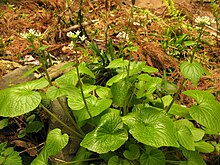
Back Wasabi Afrikaans Eutrema japonicum AN وسابي Arabic وسابى ARZ Vasabi Azerbaijani Уасаби Bulgarian Rave japonès Catalan Eutrema japonicum CEB Eutrema japonská Czech Wasabi Danish
| Wasabi | |
|---|---|

| |
| Scientific classification | |
| Kingdom: | Plantae |
| Clade: | Tracheophytes |
| Clade: | Angiosperms |
| Clade: | Eudicots |
| Clade: | Rosids |
| Order: | Brassicales |
| Family: | Brassicaceae |
| Genus: | Eutrema |
| Species: | E. japonicum
|
| Binomial name | |
| Eutrema japonicum | |
| Synonyms[3] | |
| |
Wasabi (Japanese: ワサビ, わさび, or 山葵, pronounced [waꜜsabi]) or Japanese horseradish (Eutrema japonicum[3] syn. Wasabia japonica)[4] is a plant of the family Brassicaceae, which also includes horseradish and mustard in other genera. The plant is native to Japan and the Russian Far East[1] including Sakhalin, as well as the Korean Peninsula.[5]: 133 It grows naturally along stream beds in mountain river valleys in Japan.
It is grown for its rhizomes which are ground into a paste as a pungent condiment for sushi and other foods. It is similar in taste to hot mustard or horseradish rather than chilli peppers in that it stimulates the nose more than the tongue, but freshly grated wasabi has a subtly distinct flavour.[6]: 53 The two main cultivars in the marketplace are E. japonicum 'Daruma' and 'Mazuma', but there are many others.[6]
The oldest record of wasabi as a food dates to the 8th century AD.[7] The popularity of wasabi in English-speaking countries has coincided with that of sushi, growing steadily starting in about 1980.[8] Due to constraints that limit the Japanese wasabi plant's mass cultivation and thus increase its price and decrease availability outside Japan, the western horseradish plant is widely used in place of the Japanese wasabi. This version is commonly referred to as "western wasabi" (西洋わさび) in Japan.
- ^ a b Iwashina Tsukasa [in Japanese] (2016). "Eutrema Japonicum". Curtis's Botanical Magazine. 33 (3). Wiley: 217–225. doi:10.1111/curt.12151. JSTOR 48505819.
- ^ Cite error: The named reference
Miquelwas invoked but never defined (see the help page). - ^ a b "Eutrema japonicum Koidz. Fl. Symb. Orient.-Asiat. : 22 (1930)". Plants of the World Online. Board of Trustees of the Royal Botanic Gardens, Kew. 2022. Retrieved 4 December 2022.
- ^ "Wasabia japonica". Multilingual Multiscript Plant Name Database, University of Melbourne. Retrieved 9 August 2016.
- ^ Al-Shehbaz, Ihsan A.; Warwick, Suzanne I. (2005). "A Synopsis of Eutrema (Brassicaceae)". Harvard Papers in Botany. 10 (2). Harvard University Herbaria: 129–135. doi:10.3100/1043-4534(2005)10[129:ASOEB]2.0.CO;2. JSTOR 41761810. S2CID 85833186.
- ^ a b Morgan, Lynette (2005). "Hydroponic Production of Wasabi & Japanese Vegetables". In Weller, Thomas; Peckenpaugh, Douglas (eds.). The Best Of Growing Edge International, 2000–2005. New Moon Publishing. ISBN 978-0-944557-05-1. Retrieved 9 August 2016.
- ^ わさびの歴史 [History of Wasabi] (in Japanese). Kinjirushi. 2001. Archived from the original on 18 April 2001. Retrieved 9 August 2016.
- ^ Frequency of "wasabi" and "sushi" in English-language sources from 1950 to 2008 wasabi vs. sushi in Google Books Ngram Viewer; wasabi tracks sushi, not other Japanese foods
© MMXXIII Rich X Search. We shall prevail. All rights reserved. Rich X Search